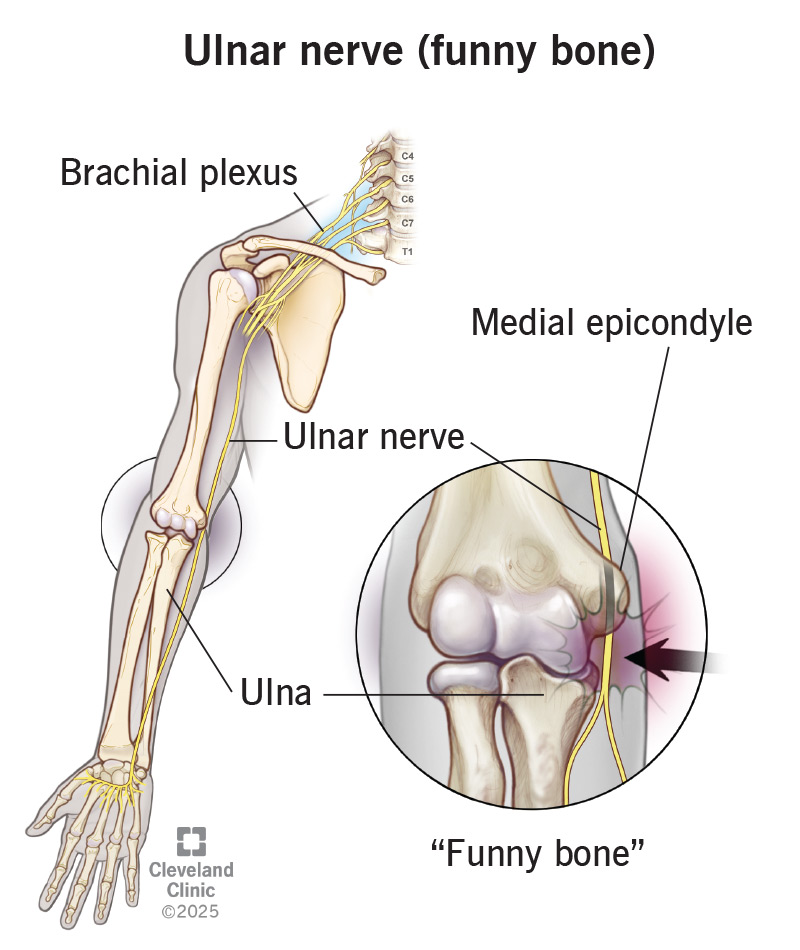Your ulnar nerve helps you grip things with your hand and aids fine motor skills like writing. It also helps your hand and fingers feel things like heat, softness and pain. A tingling, funny-feeling sensation occurs when you bump your ulnar nerve in your elbow. That’s why it’s sometimes referred to as your funny bone.
Advertisement
Cleveland Clinic is a non-profit academic medical center. Advertising on our site helps support our mission. We do not endorse non-Cleveland Clinic products or services. Policy

Your ulnar nerve helps you move your forearm, hand, and fourth and fifth fingers. Your forearm extends from your elbow to your hand. Your ulnar nerve also sends sensory information like touch, temperature and pain to your brain. This nerve is commonly known as your funny bone.
Advertisement
Cleveland Clinic is a non-profit academic medical center. Advertising on our site helps support our mission. We do not endorse non-Cleveland Clinic products or services. Policy
Pressure on your ulnar nerve can lead to certain health conditions that cause pain, numbness and weakness in your hand, arm and elbow. This can affect the way you grip items, perform daily tasks and even feel sensation. If you experience any of these symptoms, reach out to your healthcare provider. They’ll talk to you about what you’re feeling and provide solutions to make you feel better.
Your ulnar nerve runs underneath the first layer of skin near your elbow. When you bump your elbow against a hard surface, you may temporarily pinch your ulnar nerve. The impact causes a funny-feeling, shock-like tingling or burning known as “hitting your funny bone.”
Your ulnar nerve controls nearly all of the small muscles in your hand. Although your ulnar nerve begins at your armpit, it doesn’t perform a function until it enters your forearm.
As a motor (movement) nerve, your ulnar nerve stimulates muscles in your forearm, hand and fingers so you can:
As a sensory nerve, your ulnar nerve gives feeling to your:
Advertisement
Your ulnar nerve is one of five nerve branches of your brachial plexus. This nerve bundle sends sensory information and helps you move your shoulders, arms and hands.
Your brachial plexus starts as nerve roots in the cervical spine in your neck. These nerves then go behind your collarbone (clavicle), through your armpit (axilla) and down your arm.
You have a left and right ulnar nerve — one to serve each arm. Your ulnar nerve starts at the brachial plexus in your armpit and:
Your ulnar nerve branches include:
Conditions and disorders that can affect your funny bone nerve include:
Signs of a pinched ulnar nerve may include:
You should call your provider if you experience:
Advertisement
There’s nothing humorous about hitting your funny bone, which isn’t a bone at all. That tingling feeling when you bang your elbow on a hard surface is actually an ulnar nerve response. Your ulnar nerves help with movement and feeling in your forearms, wrists, and fourth and fifth fingers. But pressure on the nerve can lead to ulnar nerve entrapment and other problems.
If you experience pain, numbness or weakness in these areas, reach out to your healthcare provider. They can guide your treatment and get you on the path to relief.
Advertisement
From sudden injuries to chronic conditions, Cleveland Clinic’s orthopaedic providers can guide you through testing, treatment and beyond.

Last reviewed on 02/27/2025.
Learn more about the Health Library and our editorial process.